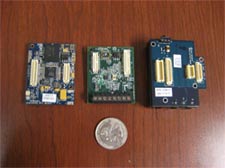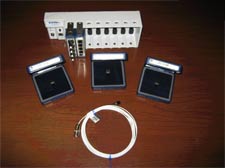MPC
Research Projects (2008-09)
Identifying Number
MPC-304
Project Title
Feasibility Study of Mobile Scanning Technology for Fast Damage Detection of Rural Bridges Using Wireless Sensors
University
Colorado State UniversityProject Investigator
Suren Chen
Description of Project Abstract
Future sustained economic growth of the nation very much depends on the reliability and efficiency of the transportation infrastructure system, which includes numerous highway bridges. In a study conducted on 503 recent bridge failures in the United States between 1989 and 2000 (Warhana and Hadipriono 2003), it was identified that "bridge failures took place primarily during the service life of the bridges". These deteriorating structures either require expensive renovations, or experience growing safety risks in future decades to come if the deficiencies are not addressed. As a result, regular inspections and monitoring are usually important in order to maintain the structural integrity of bridges. Presently, despite some limitations on identifying some hidden problems, visual inspections are still commonly used to discover deterioration and damage via observation. However, the cost of a full inspection can be quite high and time consuming, especially for a huge number of rural bridges across the country.
The 2007 report on the condition of bridges and highways shows that there are 72,264 bridges and 81,257 bridges are classified as structural deficient and functionally obsolete, respectively (USDOT 2007). Biennial bridge inspections are currently required by the FHWA. In addition to visual inspections with some limitations, health monitoring approach using sensors are currently becoming popular for bridge inspection. During the past several decades, health monitoring through dynamic properties has been pretty successful on assessing bridge performance under excitation. This excitation can be from ambient traffic, wind or test vehicles using controlled traffic typically with a large array of sensors (e.g. wired and wireless) installed on the bridge. There are, however, some limitations of current sensor technology in order to obtain accurate information for the modal properties (e.g. mode shape) for health monitoring and damage detection purposes. For example, a large number of sensors must be distributed throughout the bridge to get enough data points to form an accurate mode shape in order to detect damages (information between two sensors is typically not available). Besides, the maintenance of a large number of sensors is also challenging since the functionality and reliability of sensors is affected by the field environment. As a result, the whole monitoring process of a typical bridge can be very expensive as a result of instrumentation, maintenance and data acquisition and processing equipment for the sensor array. Thus, for local transportation agencies, i.e. state DOT, to conduct long-term monitoring of a bridge or diagnostic short-term testing of multiple bridges would be very expensive and time consuming.
Project Objective
This study aims at investigating the feasibility of a novel mobile monitoring technology to detect the potential damage on a bridge with wireless sensor technology. This technology, if proven effective, can provide continuous modal data, which is more accurate with a much faster speed and much lower cost than traditional monitoring technique.
Project Approach/Methods
- Task 1-Adaptive Mobile Vibration Detection Scaled Prototype-The adaptive mobile vibration detector (AMVD) module is inspired from the level-type adaptive mass-damper system. There have been numerous studies on various types of tuned mass dampers in past decades by many researchers in structural control. This particular level type mass-damper was proposed because of its low requirements of the mass stroke and the adaptive tuning capability through adjusting the distance between the mass block and the pin (Gu and Chen 2001; Cai and Chen 2004). It is proposed for application in this study with attached accelerometers on the small mass block to provide continuous acceleration information over the bridge. Based on the recent study of tuned mass dampers installed inside the cargo of the truck, it was determined that the mass dampers can amplify the dynamic response which carries the detailed dynamic information from the bridge, once it is well tuned to the targeted frequency range (Chen and Wu 2008). The adaptive nature of the AMVD via a servo motor makes the AMVD easily adjustable and thus be able to match the actual vibration frequency of the bridge mode. In this Task, the AMVD will be designed and manufactured in the 1:10- 1:15 scaled down model for the study. Two wireless accelerometers will be put inside the AMVD.
- Task 2-A model bridge damage detection testing in laboratory-As a feasibility study, a three-span bridge (2m+3m+2m uniform beams) will be used for the experiments in the structural laboratory at CSU. The first span is a simple-supported beam and the second and the third spans are continuous. Beams made of two types of material (wood and steel) will be tested, respectively. Three PCB piezoelectric accelerometers will be distributed evenly along each of the spans. The AMVD scaled prototype will be put on the wheels and pulled by a model truck. The AMVD will firstly be calibrated to match with one critical mode of the beam. The adaptive capability will be also evaluated through easily adjusting the natural frequency of the level-type TMD. The model truck will be attached with additional weight to match the weight ratio with the typical weight of the real truck. The truck will be pulled by a motor to move through the beams. In order to have enough time for the AMVD to fully vibrate, additional 2 m approaching beams will be connected on both sides of the beams. A video camera will record the process of the AMVD moving through the bridge.
Testing scenarios will include:
(a) Healthy condition: the girders are intact.
(b) Damaged conditions: there is 1, 2, 3-inch cut in the middle, quarter of each span, respectively.
Considering uncertainties associated with testing equipments and operations, the researchers will repeat the test under each condition for three times. Most required equipment for this study has already been owned by the PI which can be used on the project without additional costs (Fig. 1). The major equipment cost needed of the study is manufacturing the testing beam, prototype model of AMVD and several additional necessary sensors.
Imote2 Wireless accelerometer

Data acquisition system and accelerometers

Fig. 1 Available Equipments in the Structural Laboratory at CSU
- Task 3-Data calibration on both healthy and damage conditions-Data acquisition system will collect the accelerations from the accelerometers installed on the bridge. The wireless accelerometers inside the AMVD will send signal to the computer in the laboratory. The data from sensors on the bridge, on AMVD and the image clips from the video camera will be synchronized with time stamp. As a result, the data from two series of sensors can be synchronized in both time and spatial domains. The acceleration data measured from the AMVD will be processed to derive the modal properties of the bridge based on the vehicle-bridge interaction model developed by the PI (Chen and Cai 2007; Chen et al. 2006; Cai and Chen 2004). Modal frequency, mode shape and mode shape curvature will be compared. The comparison will focus on if the signal derived from the sensor inside the AMVD can disclose accurate modal properties (e.g. modal frequency, mode shape and mode shape curvature) through comparing with those from the sensors on the bridge. Further analysis with existent damage detection theory will be applied to check the sensitivity of identifying the potential damages with the proposed idea.
MPC Critical Issues Addressed
This research will address several MPC critical issues including: 1) Infrastructure longevity; 2) Heavy vehicles and commercial trucks; 3) Improved infrastructure design.
Contributions/Potential Applications of Research
In a long run, the proposed approach, either working directly for monitoring and mandatory inspections through providing more reliable data, or working as a quick scanner to identify local deficiencies for further detailed inspections, is very promising due to its significantly lower costs, high scanning speed and easy mobility from one bridge to another compared with traditional dynamic testing. Once the approach is proven effective and applied into practice, the payoff will be quite significant considering the large number of bridges requiring regular inspections. Once the approach is proven effective and applied into practice, the payoff will be quite significant considering the large number of bridges requiring regular inspection. For example, there are 599,893 bridges in the whole country, most of which are rural bridges.
As encouraged by MPC, significant student involvement in this project is planned. One graduate research assistant, along with undergraduate student workers, will be involved into this whole study and the whole budget will mostly be used to pay the student researchers and the cost associated with the laboratory testing with minimum salary for the PI.
Technology Transfer Activities
Once the proposed idea, if funded, is proven effective under a laboratory environment. Nearby DOTs and other stakeholders will be immediately contacted about the technique. Resources will be leveraged to manufacture 1:1 full-scale prototype AMVD which will be tested on local bridges in neighboring states, such as Colorado and Wyoming, and related patents will be filed. The PI has discussed the idea with Wyoming DOT and Colorado DOT and they both have expressed interests on the proposed study and like to see how the technology works. Wyoming DOT has kindly agreed to accommodate field testing on their bridges when the full-scale prototype equipment is built.
Time Duration
July 1, 2008 – June 30, 2009
Total Project Cost
$84,851
MPC Funds Requested
$34,851
TRB Keywords
Rural bridge, damage detection, wireless sensor, mobile testing

